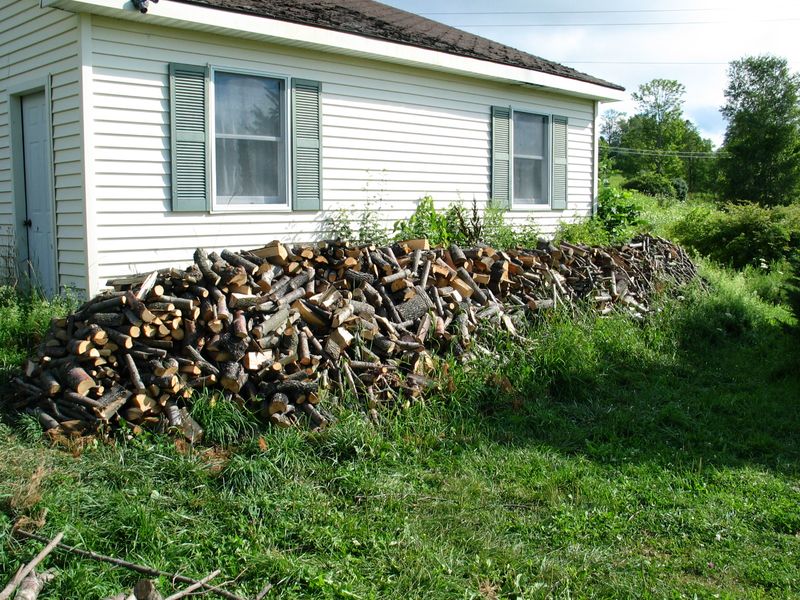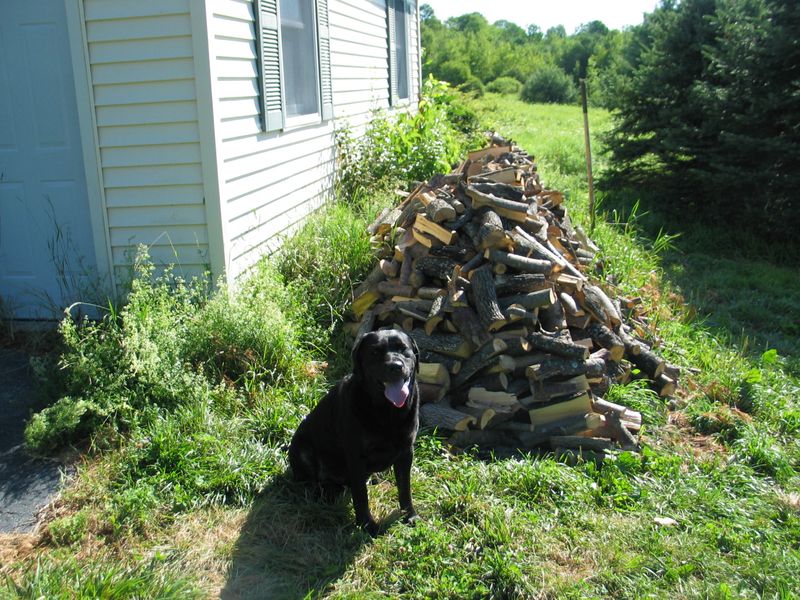It’s already the end of July, and my last blog entry was in March. How did that happen? I meant to write a blog on woodcock and how cool they are when they return in the spring and do their courtship displays, but somehow that now seems out of date. Next year. Similarly, I thought I’d write a blog about getting my first turkey, except that a very busy legislative session and a couple of bad colds kept me from going turkey hunting (the season is in May). Again, next year.
So now, I am starting to think about duck season, but that’s still a little far off to write about. So, something else I enjoy in a similar way to getting my own food hunting is cutting my own firewood. Right now, I’m just putting the finishing touches on my woodpile. 
I cut about three cords per year the old fashioned way—no chain saws. Unlike duck hunting, this is a hobby that actually saves me some money!
When I tell people I cut my own firewood without a chainsaw, most people respond either with disbelief or they ask: “How much do you cut?” as if they expect me to say ¼ cord. Cutting lots of firewood without a chainsaw is not a big deal though. You just need to think of it as a hobby, not a chore. I’m a former competitive swimmer and still do a lot of swimming. Many people run six miles a day. Cutting firewood by hand is no different in terms of effort from either of those activities. I think many people think of firewood cutting as a task to complete in a couple of weekends. With a chainsaw and power splitter, that’s possible, but I like the cross training cutting and splitting wood by hand provides. I also like avoiding gasoline fumes, and my dogs can hang out with me while I cut wood with a bow saw (the noise of a chainsaw would scare them).

(Percy likes the woodpile!)

(Atlas finds the woodpile boring.)
Of course, given who I am and what I do, I think about the environmental effects of my wood burning. Since I don’t use a chainsaw, I have lots of time to do that. Many people say that burning wood is carbon neutral. That is certainly wrong. Burning wood releases carbon dioxide, and the atmosphere doesn’t know the difference between carbon dioxide from fossil fuels and carbon dioxide from wood.
In fact, burning wood releases more C02 than burning oil: 195 pounds per million British Thermal Units (mbtu) compared to 161 pounds per mbtu, according to the US Energy Information Administration (see: http://en.wikipedia.org/wiki/Greenhouse_gas) if you just consider emission from the actual burning, although these numbers are only rough guidelines because even direct CO2 emissions can be quite variable. In the case of wood, emissions per btu will vary dramatically depending on moisture content and burner efficiency, for example.
Full life cycle CO2 emissions for oil also vary greatly, in part because of how much energy it takes to extract the oil from the ground (burner efficiency will also matter in the case of oil, but home furnaces will vary less than wood stoves). For example, making diesel fuel (which is the same as number #2 heating oil, the type we mostly burn in Maine) from Canadian tar sands or Venezuelan heavy crude can add another 40 pounds of CO2 per mbtu over the full life cycle of the oil when compared to conventional domestic crude oil. This is because the Canadian and Venezuelan oils are hard to extract. Although it seems counterintuitive (and I confess I have my doubts about these numbers, though no evidence to support these doubts), transportation of the oil doesn’t significantly change the CO2 emissions, so diesel from Saudi Arabian oil, which is easy to extract, doesn’t result such a dramatic increase in CO2 emissions when compared to conventional domestic oil over their full life cycles. Burning Saudi Arabian oil results in about 25% more CO2 emissions than burning conventional domestic crude, but burning Canadian tar sands oil results in more than 200% more CO2 emissions. (See http://www.netl.doe.gov/research/energy-analysis/life-cycle-analysis/lca-listing?prog=fuels)
But, you may say, trees grow back, right? Maybe. We don’t know how growing conditions will change over the next 40 or 50 years. Also, cutting down a tree stops it from sequestering carbon. A new tree, even if it does eventually grow, will take decades to gain the same ability to turn CO2 into wood as the nice big tree we just cut down. And, if we hadn’t cut the tree down, it would have gone right on turning carbon in the air into more wood over those decades, and it would get really big and really good at turning CO2 into wood! So, if you think you are having no impact on atmospheric carbon levels by burning wood, you are wrong.
Is there any reduction in greenhouse gasses from burning wood as compared to burning fossil fuels? There are no simple answers to that question and many factors to consider. The best I can do is say: “maybe,” if you do things right. This issue is so complex that it often gives me a headache thinking about it. In fact, my head is hurting now, so I’ll continue this discussion in my next blog entry. If you want some good bed time reading that will help you grapple with this issue in the meantime, take a look at the Manomet Center for Conservation Science’s Report for the state of Massachusetts at http://www.mass.gov/eea/docs/doer/renewables/biomass/manomet-biomass-report-full-hirez.pdf. It’s the most thorough work on this issue that I know of, and it will challenge your brain. More soon.











You are officially my new favorite blogger. Look forward to part 2.
https://northernwoodlands.org/articles/article/another-view17/
Thanks, Sandy. Manomet responded to Mr. Strauss’s critique. I strongly agree with Manomet’s response. -Nick
That’s enough firewood for cold season and I think I should stock our own. I think it’s best to start this morning as the weather is fair.
I agree that the subject is complex. Regarding carbon debt, there seems to be a need to study re-generation closer. For instance, in a mature Aspen stand, the trees are essentially the same identical plant over a large area as signified by an exact match of their DNA and age. I believe the largest plant in the Guiness Book of World Records is a stand of Aspen. My point here is that if you harvest this type of forest, you will typically clear-cut it because there is no age strata. This is common in my state of Michigan. Re-planting is not necessary as the Aspen will re-generate without assistance. Within 7 to 10 years the young trees will be approximately 15 feet with 100% ground coverage of leaves from the tops down to about 4 feet from the ground. The mature forest that was clear-cut reached heights of approximately 50-60 feet but the canopy ended at about 20 feet below the tops, and there are plenty of gaps where the sun can reach the ground briefly during the day. To summarize, with a mature stand of Aspen, the canopy is about 20′ thick with many significant patchy spots. With a young re-generation, the canopy is 10 feet thick with no bare spots. I wonder which has more mass and/or surface area of those neat little green photo-synthesis factories? P.S. We don’t burn Aspen for firewood, but it is commonly used for boiler fuel in larger plants. Eric W.
Thanks for your comment, Eric. I appreciate your taking the time to read my blog. – Nick